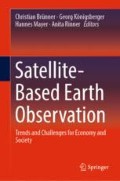Abstract
Hazard always arises from the interplay of social and biological and physical systems; disasters are generated as much or more by human actions as by physical events and there is a proofed impact of global warming on natural disasters. In recent years, Remote Sensing technologies has been of considerable interest concerned with emergency services and disaster management. The objective of this paper is not to provide an overview of how Earth observation technologies can be used in the management of natural hazards in details and in case studies. The focus lies in the documentation of the requirements for the usage of Remote Sensing images within the topics of natural hazards and disaster management on different scales (from global to local aspects). Some examples of international operational mechanisms (Charter, Copernicus, ZKI), serving rapid mapping on Earth observation data will be pointed out.
Access this chapter
Tax calculation will be finalised at checkout
Purchases are for personal use only
References
Bayfield N (1996) Approaches to monitoring for nature conservation in Scotland. In: Umweltbundesamt (ed) Monitoring for nature conservation 22, Vienna, 23–27
Bello OM, Aina YA (2014) Satellite remote sensing as a tool in disaster management and sustainable development: towards a synergistic approach. Procedia Soc Behav Sci 120:365–373. https://doi.org/10.1016/j.sbspro.2014.02.114
Deutsches Zentrum für Luft- und Raumfahrt (DLR) (2017) Das Zentrum für satellitengestützte Kriseninformation (ZKI), https://www.zki.dlr.de/. Accessed: 2017-11-30
Dikau R, Pohl J (2011) Hazards: Naturgefahren und Naturrisiken. In: Gebhardt H, Glaser R, Radtke, U, Reuber P (eds) Geographie. Physische Geographie und Humangeographie. (Spektrum Akademischer Verlag) Heidelberg, pp 1114–1169
Eguchi RT, Huyck CK, Ghosh S, Adams BJ (2008) The application of remote sensing technologies for disaster management. In: Proceedings of the 14th world conference on earthquake engineering, 12–17 Oct, Beijing, China, p 17
European Space Agency (ESA) (2016) International charter space and major disasters. Available from: https://www.disasterscharter.org/. Accessed: 2017-11-30
European Commission: Copernicus Emergency Management Service. Available from: http://emergency.copernicus.eu/. Accessed: 2017-11-30
Gähler M (2016) Remote sensing for natural or man-made disasters and environmental changes. In: Marghany M (ed) Environmental applications of remote sensing, pp 309–338. https://doi.org/10.5772/62183
Gens R, Van Genderen JL (1996) 9 SAR interferometry—issues, techniques, applications. Int J Remote Sens 17:1803–1835
Glade T, Dikau R (2001) Gravitative Massenbewegungen—vom Naturereignis zur Naturkatastrophe. Petermanns Geogr Mitt 145(6):42–53
International Charter “Space & Major Disasters” (2016) 2016 annual report. https://disasterscharter.org/documents/10180/66908/16thAnnualReport
Joyce KE, Belliss SE, Samsonov SV, McNeill SJ, Glassey PJ (2009) A review of the status of satellite remote sensing and image processing techniques for mapping natural hazards and disasters. Prog Phys Geogr 33(2):183–207. https://doi.org/10.1177/0309133309339563
Kerle N (2013) Remote sensing of natural hazards and disasters. In: Bobrowsky PT (ed) Encyclopedia of natural hazards. Springer, Dordrecht, pp 837–847
Krishnamoorthi N (2016) Role of remote sensing and GIS in natural-disaster management cycle. Imp J Interdiscip Res (IJIR) 2(3):144–154
Merified PM, Lamar DL (1975) Active and inactive faults in southern California viewed from Skylab, TM X-58168, vol 1, NASA, pp 779–797
Münchner R (2017) TOPICS GEO natural catastrophes 2016 Analyses, assessments, positions 2017 issue. https://www.munichre.com/topics-online/en/2017/topics-geo/world-map-2016#furtherinformation. Accessed: 2017-11-30
Oštir K, Veljanovski T, Podobnikar T, Stančič Z (2010) Application of satellite remote sensing in natural hazard management: the mount mangart landslide case study. J Int J Remote Sens 24(20):3983–4002. https://doi.org/10.1080/0143116031000103826
Rib HT, Liang T (1978) Recognition and identification, in Landslides—analyses and control, In: Schuster RL, Krizek RJ (eds) National academy of sciences, Washington DC, pp 34–69
Seier G, Stangl J, St Schöttl, Sulzer W, Sass O (2017) UAV and TLS for monitoring a creek in an alpine environment, Styria, Austria. Int J Remote Sens 38(8–10):2903–2920. https://doi.org/10.1080/01431161.2016.1277045
Seier G, Kellerer-Pirklbauer A, Wecht M, Hirschmann S, Kaufmann V, Lieb GK, Sulzer W (2017b) UAS-based change detection of the glacial and proglacial transition zone at pasterze glacier, Austria. Remote Sens 9(549). https://doi.org/10.3390/rs9060549. www.mdpi.com/journal/remotesensing
Seier G, Sulzer W, Wecht M (2017c) Veränderungsdetektion eines Wildbaches mittels unbemanntem Luftfahrzeug. In: AGIT—Journal für Angewandte Geoinformatik 3, Herbert Wichmann Verlag, VDE VERLAG GMBH, Berlin Offenbach. https://doi.org/10.14627/537633037
Titz A (2015) Naturgefahren und Naturrisiken im Nepal-Himalaya. Dissertation an der Justus–Liebig–Universität Gießen, Gießen, p 245
Van Westen C (2000) Remote sensing for natural disaster management. Int Arch Photogramm Remote Sens 23(B7):1609–1617
Van Westen C (2013) Remote sensing and GIS for natural hazards assessment and disaster risk management. In: Schroder JF, Bishop MP (eds) Treatise on geomorphology (Remote Sensing and GI Science in Geomorphology) 3, Academic Press, Elsevier, San Diego, pp 259–298
Author information
Authors and Affiliations
Corresponding author
Editor information
Editors and Affiliations
Rights and permissions
Copyright information
© 2018 Springer International Publishing AG, part of Springer Nature
About this paper
Cite this paper
Sulzer, W. (2018). Natural Hazards and Earth Observation. In: Brünner, C., Königsberger, G., Mayer, H., Rinner, A. (eds) Satellite-Based Earth Observation . Springer, Cham. https://doi.org/10.1007/978-3-319-74805-4_23
Download citation
DOI: https://doi.org/10.1007/978-3-319-74805-4_23
Published:
Publisher Name: Springer, Cham
Print ISBN: 978-3-319-74804-7
Online ISBN: 978-3-319-74805-4
eBook Packages: Law and CriminologyLaw and Criminology (R0)

